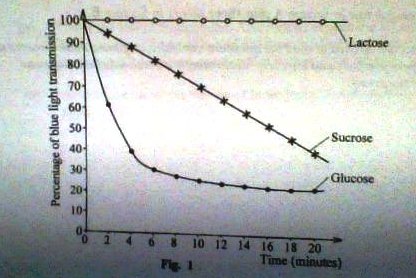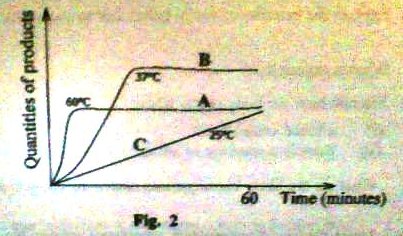1. Describe the physiological adaptions of;
a) vertebrates living in dry environments, giving examples in each case.
b) plants to water shortage.
2. Methylene blue is an indicator which is blue when oxidized and colorless when reduced. The intensity of light passing through a mixture of solution/ reactants containing Methylene blue can be measured. A 100% transmission of blue light means that the Methylene blue is in a complete oxidized state.
Three solutions were mixed in test tubes as shown in table 1.
Table 1
|
Test tube |
Contents of the test tube |
|
1 |
10cm3 of yeast suspension + 10cm3 of 0.5% glucose + 1 cm3 of 0.1% Methylene blue |
|
2 |
10cm3 of yeast suspension + 10cm3 of 0.5% sucrose + 1cm3 of 1% Methylene blue. |
|
3 |
10cm3 of yeast suspension +10cm3 of 0.5% lactose + 0.1% Methylene blue |
The test tubes were covered and maintained at 350C for 20 minutes.
At 2 minutes intervals, the percentage of blue light transmitted through the test tube of each solution was measured and the results are as shown in figure 1
a) i) Compare the changes in the percentage of blue light transmission theough the test tubes containing glucose and sucrose.
ii)Explain the difference(s) in (a) (i)
b) Explain the differences in the variation of blue light transmission through the test tubes containing lactose and sucrose
c) i) Suggest what would happen to the blue light transmission if lactose was mixed with lactase instead of the yeast suspension.
ii) Sketch a graph to illustrate your answer.
d) In another experiment, changes in products of an enzyme – catalysed reaction were determined at 250C, 370C and 600C. The results were presented graphically as shown in figure 2. Study the figure and answer questions that follow:
Explain the patern of changes in the quantities of products of reactions at each temperature.
i) A
ii) B
iii) C
e) Suggest what would happen to the reaction if the temperature was maintained at 450C.
3.a) How does instinctive behavior differ from learned behavior?
b)Explain the benefits of social behavior to social animals.
4. Explain the reproductive strategies of flowering plants that have led to their;
a) diversity
b) survival
5.a) What is immunity?
b)Explain how the body reacts when;
i) a blood vessel is cut
ii) there is a presence of antigens in the body.
c) What are the likely consequences of over bleeding to an individual?
6.a) Using the law old Independent Assortment, explain the 3:1 ratio in the F2 generation of a monohybrid inheritance when one parent is homozygous dominant and the other homozygous recessive for a trait?
b) Give situations where the law of Independent Assortment may not apply.
END


